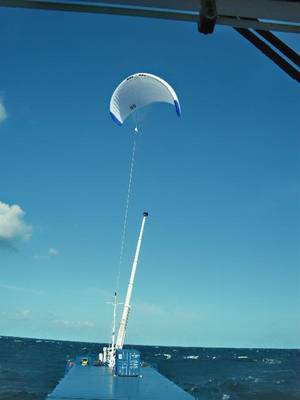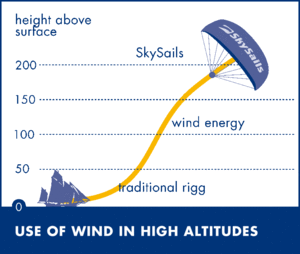Hoisting the SkySails
Interview with
Ben - We are talking about sustainable shipping today and one idea put forward has been to find ways to harness the power of the wind in its rather traditional role of filling some sails. I spoke to Stephan Brabeck from the German company, SkySails.
Stephen - We started to develop SkySails because we could see that the oil price will rise and also nature has to be saved more and more. And we thought about ways to find a solution to prepare ships with alternatives than just the propulsion or the main propulsion depending on fuel. So there, the idea came up. We looked at kite-surfers, how much power they generate with their small kite-surf kites and we asked how to transform this technology to big ships.
 Ben - Because of course, wind power is one of the oldest ways that we've powered ships in the entirety of human history...
Ben - Because of course, wind power is one of the oldest ways that we've powered ships in the entirety of human history...
Stephen - Yes, but the former sailing ships came out of attention because fuel was so cheap on one side and on the other side, nowadays, the ship has to be clear - we have to have a clear deck to load and unload-so you cannot afford a masts to hold the sails. And so, we came to the idea to have a system which you can store away during unloading and loading of a ship.
Ben - How have you developed that idea to build a SkySail? What physically is the SkySail?
Stephen - The SkySail is a parafoil which is attached by a rope to a ship. We use a parafoil instead of a kite. It's filled with air and so, we fly it in profile through the air and the profile has much more lift than a single sheet of cloth, that was the idea; to use this parafoil to generate high thrust which is able to tow a ship at the minimum, 50 to 60% of the main propulsion.
Ben - So this parafoil design, it's essentially a series of chambers in the cloth, rather than just a sheet of cloth, and that gives you much better performance?
Stephen - Yes, that's correct. The cloth itself of the parafoil is like sail cloth, a little bit reinforced against UV-radiation and also, at the line attachment points where we have to transmit this high load to the rope and to the ship.
Ben - So you obviously have to reinforce it if you're putting that much force to it. The rope itself, can you just use traditional sailing rope or does that also have to be reinforced?
Stephen - The rope itself is a very modern material. It has about 10% of the weight of a steel rope of the same strength, and on the other side, it is very durable; made from Dyneema, that's a very new fibre and very strong fibre. The real challenge was to include, to introduce into the rope, a cable; because you can imagine that we have to steer this kite and for the steering purposes, we have a small control pod between the kite and the rope. There are some computers in there and also, an electric motor to control the kite. This motor needs energy and so we have to include into the rope a cable, and that was also a special development.
Ben - And what altitude do they actually fly at? Presumably higher than a conventional sail would be able to?
Stephen - Yes. We fly the system between a height of between 100 and 300 metres. In this height, we have about 25 to 30% more wind than close to the surface of the water. Due to the circumstance that we have left the boundary layer of the Earth's surface at about 100 metres, then we have the full wind, so we have about 25 to 30% more wind force there.
Ben - What conditions can you fly it in? Does it need to be perfect weather? Does the wind have to be going in exactly the right direction or are there tricks that you can employ to use them in not so great weather or when the winds going on a bit of a tangent?
 Stephen - We use about 180-degrees of the wind, like a sailing boat, so we can also even go a little bit against the wind and keep the system flying, but the most profitable course is from 90-degree to 270-degree downwind and reaching wind. If we have stronger winds, either we don't start or we can also leave the system in the heavens in static condition, so the captain has not to care about to this system just flying, but without making figures to generate power.
Stephen - We use about 180-degrees of the wind, like a sailing boat, so we can also even go a little bit against the wind and keep the system flying, but the most profitable course is from 90-degree to 270-degree downwind and reaching wind. If we have stronger winds, either we don't start or we can also leave the system in the heavens in static condition, so the captain has not to care about to this system just flying, but without making figures to generate power.
Ben - You don't just deploy the kite and allow that to pull it along. You actually have to make these weaving patterns to get more power out. How does that work?
Stephen - The kite is moving with a velocity of about 50 miles per hour to 150 miles per hour and the kite will be manoeuvred in kind of a figure 8 in front of a ship. The lift of a parafoil is growing by square with the velocity of the wind. That is the reason why we can generate with such a small surface, such a high thrust. There are sailing vessels of about 100-metre length with cloths of 3,000 square metre. We can generate the same thrust with about 160 to 200 square metre.
Ben - What sort of difference does that actually make to fuel usage?
Stephen - On a small ship, about 4,000 tonnes, about 90-metre long, then we can save about 1 to 1 ½ tonne per day at sea with this system on average. So we have not every day the condition to use the system, but if we use the system then the savings are very high: Up to 50 or 60%. Such a ship consumes about 6 tons of fuel per day. If we are working, we save about 3 tonnes per day, but in average over the year, it's 1 to 1 ½ tonnes per day, so over the year, 300 tonnes and that means EUR90,000 to EUR120,000 savings per year for the customer, for the owner. And on the other side, for the ecological side, we save between 600 and 900 tonnes of carbon per year.
- Previous Sustainable Shipping
- Next Dolphins and bird life in Cardigan Bay









Comments
Add a comment